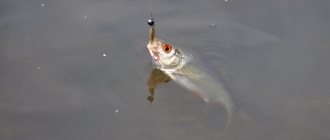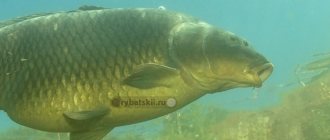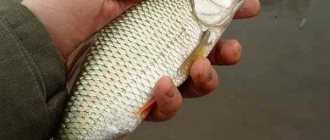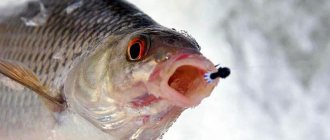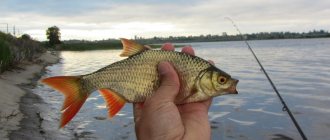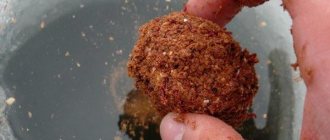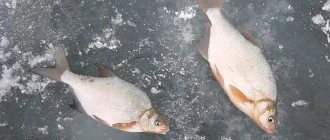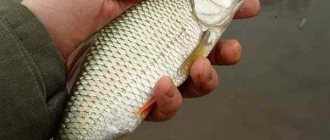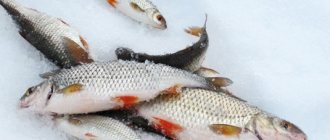Roach fishing in winter holds a special place in the heart of every winter angler. When neither bream, nor crucian carp, nor even perch are caught, the roach helps out. But this does not mean that winter fishing for roach is a simple activity. Sometimes in winter it is possible to catch a lot of this fish from the ice without preparation, but such luck is rare, and the catches usually contain roach weighing up to 120 grams.
To catch roach constantly, you need to know the subtleties and some biological features, and use as much knowledge as possible. The silvery beauty does not hibernate in winter, alternating periods of high and low feeding activity. Roach is present in large numbers in water bodies, but not everyone catches it in winter. The fisherman needs to find a feeding school or entice inactive fish to bite.
Features of winter behavior
You can catch roach in winter. You just need to understand some of the biological features of its behavior. Fishing for roach in winter is changeable, but this is not to say that this fish is unpredictable. Capricious - yes, probably. The strong weather dependence of roach, especially in winter, has long been known.
Factors influencing winter bite:
- Time of year, seasonality phenomena.
- Atmospheric pressure, weather and wind.
- The type of reservoir and its specifics - depths, dimensions, food supply, plankton migrations.
- The region - our country is large, and the habitat conditions of this fish vary. Taran, serka - on the Don, vobla on the Volga, chebak in Siberia, sorog in the northern regions - all these names belong to the same species.
- What do roaches eat in winter in this body of water?
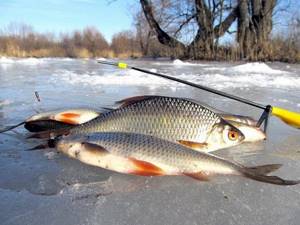
The influence of weather on roach biting
In winter, roach bite unstably, but it is easy to catch if you know the habits and stopping points on a particular body of water. And the reason for this is the weather and water conditions. Underwater currents, water temperature, movement of zooplankton masses, dissolved oxygen levels - everything affects the bite. It has been noticed that any fish bites better in winter when the weather is constant, without sudden jumps and changes. It should be taken into account that in cold water fish do not need a lot of food, since calorie consumption with a slow metabolism is small.
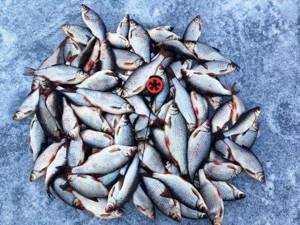
At what pressure does a roach bite better in winter?
The fish feels great at both high and low atmospheric pressure. Atmospheric pressure does not directly affect its condition - this is a myth. Pressure is simply a measure of atmospheric changes. As the weather changes, the situation in the reservoir also changes, and feeding cycles shift. When the bite is bad, you should complain not about the weather, but about the wrong fishing tactics. With sudden changes, the fish simply do not have time to adapt to the new conditions.
The biting at this time can either stop or resume with renewed vigor. The fish may not bite even in seemingly fine weather - simply because it has already eaten enough the day before. In some weather you need to feed and wait until the active fish gathers on its own. in the other - look for a school standing still, slip the bait under the fish’s nose.
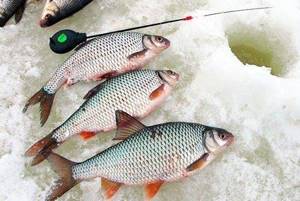
In what winter weather does roach bite best?
The best atmospheric pressure for catching roach is constantly high, average or slightly below normal. The main thing is that there are no sudden jumps. Uniform, gradual changes are acceptable. The soroga is active all winter. Therefore, in January and February, when other fish are not particularly active, fishing can be very successful, as long as weather conditions permit.

Wind influence in winter
The wind also affects the bite. In strong and gusty winds, fish are often not caught. This is more relevant for large bodies of water. Even thick ice in strong winds on reservoir areas moves in waves, which are noticeable only by fluctuations in the water level in the hole. At such moments the bite is poor or non-existent.
For biting, you need quiet, stable weather, without surges in atmospheric pressure, sudden increases and decreases, and without strong gusty winds. Other weather factors are not so important - fish are caught both in the thaw and in twenty-degree frost, day and night.
Where to look for roach in winter
Winter fishing for sorog depends greatly on the fishing location. Successful fishing for this fish is the result of an active search. Three main pillars of winter roach fishing:
- The weather is suitable.
- The right place to fish.
- Selection of gear, baits and fishing techniques.
Search and catch tactics
Ice fishing for roach in winter is based on a search strategy. If in small rivers this fish is present almost everywhere in certain quantities, then in large reservoirs and lakes it migrates quite actively in winter in search of food and oxygenated water.

Favorite habitats in reservoirs
Sorozhka is a schooling fish. And it is divided into flocks according to age and size. The size of the fish that bites is the one that stands under the hole. If you start catching small roach while fishing, we move to another place or wait for the next flock to arrive. To catch a large roach in winter, you need to find it. Adult roach are not as lively as small ones, and stay in separate small schools deeper.
Hole fishing tactics
During operational searches, some roach fishermen fish holes using a curious method: they start fishing not from the ground itself, but approximately 50-70 cm from it. On many lakes it is not difficult to fish with this method - the bottom is relatively clean and level. The question may arise: why exactly such manipulations? What prevents you from lowering the bait all the way to the ground and retrieving it in the classic way? But such wiring from the very bottom soil is only an unnecessary waste of time when actively searching for fish sites. And a small jig, playing almost half-water, is clearly visible to roach from considerable distances, which means the sector of influence on it is seriously expanding. Therefore, when searching, you can make holes at a considerable distance from each other, and not worry that you jumped over the flock - not after 6-7 m, but through all 11-13 m.
Read: Catching catfish in December
Winter habitats
In the cold season, roaches move to deep areas, away from the shore. The optimal fishing depth is up to 5-6 meters. This fish doesn't stand any deeper. The parking location also depends on the amount of oxygen - the flock will not enter musty shallow muddy backwaters.
Catching roach in winter will be successful in large areas with a slightly silted or hard bottom with numerous irregularities and changes at depths of 4-5 meters, on long exits from pits. The fish avoids strong currents, but likes to stand next to it in calm water. The main thing is that there is food, so there will be no track on bare sand either.

Winter parking areas
- The largest roach, weighing up to a kilogram, lives in deep holes with underwater vegetation and colonies of dracena shells, often next to schools of bream. A mature sorog feeds on these shells, crushing the shells with its pharyngeal teeth.
- The number of such trophies is small, and it is advisable to hunt for them if the specific habitat is known. Therefore, the main fishing object is a medium-sized fish, weighing 200-400 grams.
- In winter, roach gather in large schools, and if you find an approximate square of its habitat, you can fish here all winter. In such places, fishing towns of tents are formed. True, due to the rotting of bait residues (or other factors), the fish can leave at any moment. Therefore, some fishermen prefer to search on their own, rightly hoping for larger specimens.
On small rivers
Finding roach in winter on small rivers is easier than on large reservoirs, due to the simple determination of the approximate bottom topography. And there are simply no vast areas for migration here. Holes are drilled in deep-water areas with vegetation, exits from pits, in places with reverse flow, and in sinkholes under a steep bank. Small rivers are promising places for fishing. Local fishermen, who thoroughly know their home rivers, catch roach in such treasured places all winter.
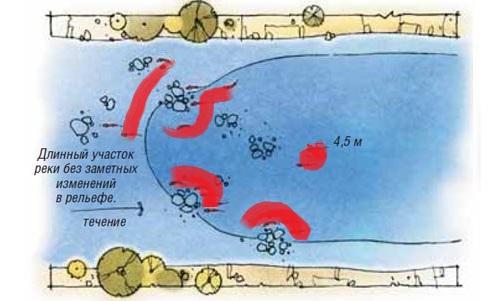
Promising places to search on the river
On reservoirs and lakes
Catching large roach in winter is most successful in large reservoirs or lakes. Here the fish gather in huge schools; the fisherman can count on a very decent catch if he finds these clusters. For example, catching rams in winter on the Tsimlyansk Reservoir, in a favorable situation, no longer resembles fishing, but commercial fishing. This usually happens already in March, when huge flocks, preparing for spawning, come closer to the shore and begin to feed intensively.
Where to look for roach in the reservoir in winter:
- In areas with a depth of up to 6 meters, with drops and shelters.
- Soroga loves flooded beds of streams, rivers, pits and ditches.
- If such an anomaly is found in a long, flat area, do not doubt that this place will gather the entire flock from nearby water areas.
- Good places are large patches of medium depth, rich in food, rising above the prevailing bottom topography far from the shores.
Catching roach on a natural lake in winter is no different. But if the reservoir is not shallow, then you should look close to the shore, at an acceptable depth or near the islands. Of course, this is not a complete list of places where you can catch roach in large bodies of water in winter. Due to the sheer size of our country, the variety of possible conditions is great. We have noted the main trends, but the details need to be clarified when directly preparing for winter fishing, using information from forums or from local experts.

Places to look in winter
On ponds and quarries
Catching roach in quarries, especially old ones in which an ecosystem has already formed, can also be successful in winter. But here it is important to take into account some features. Firstly, in quarries it is impossible to determine the bottom topography by external signs; under a steep bank there may be a shoal, and under a flat bank there may be a deep hole. Such reservoirs were formed artificially. Here an echo sounder or depth gauge will come to the aid of the fisherman. Winter gear for roaches in the still water of a quarry needs to be as light and inconspicuous as possible - after all, the water here is usually clean, especially if the bottom is rocky.
Catching roach in winter is also possible in a pond, the main thing is that it is found there. Fishing can be successful even in a very small pond, the main thing is to choose the right keys. Pond conditions are different in winter. The general pattern is that the largest roach will always occupy the best places for it, simply because there are not as many of them in the pond as in reservoirs. And if you find such a place, you can count on a significant catch.

Place and time of fishing
A large number of sorog in water bodies does not mean that it is easy to catch. In the cold season, it does not move as actively as in summer; it is not always possible to lure it with a handful of bait. And if there is no fish under the hole, then neither finely tuned gear nor fishing tricks will help. In other words, you need to look for roaches, and this often takes a lot of time.
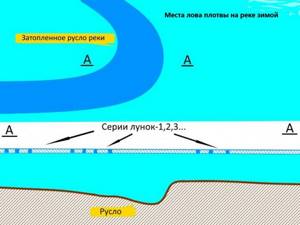
Roach fishing spots on the river in winter
According to many years of observations, in winter it sticks to certain places from which to start searching. Let's look at them in more detail:
- Deep holes. Great depths attract many peaceful fish with their comfortable conditions. Here you can hide from predators and “warm up” a little, because at a depth, starting from 7-8 meters, the water temperature is several degrees higher than at the surface. Typically, roaches do not change their winter mooring sites; these are the same pits from year to year. Finding them is quite simple; the guide is a dense cluster of fishermen or holes left by them.
- River bed. For wintering, roach also often chooses the riverbed part of a reservoir, where there is not only a suitable depth, but also a current. Lakes and reservoirs with standing water are not included here; this applies exclusively to rivers. Even a very weak water flow maintains the oxygen regime and brings food, and the fish don’t need anything else. It is not surprising that trophy specimens of sorog are most often found in such places.
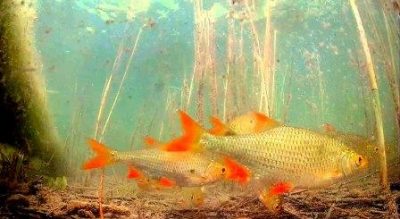
Bays. If the depth of the bay exceeds 3 meters, it should also be classified as a promising place. Although the fish here are smaller than in the river-bed pits, they are not so capricious. Just for a novice winter fisherman, especially since it’s easy to see the perimeter of the bay even in winter.- Areas with a relief bottom. Finding them on a familiar body of water is not a problem, but on an unknown one you can find them by accident. It happens that one fisherman has already “grown” a mountain of roach, but the neighbor next to him still hasn’t gotten a bite. What's the matter? The first one was lucky enough to land on a ridge, pit or some other bottom anomaly, and the second one lowers the bait onto a completely flat surface. In this case, he has only two options: wait until the competitor has caught enough and leaves, or look for his own catching place.
Roach is excellently caught at the beginning of winter, at the end and in early spring (on the first and last ice). During the day there are several bursts of activity of this fish. As a rule, this happens in the early morning, at midday and an hour and a half before dark.
Dependence of the bite on the season
Biting in winter on the first ice differs from fishing during the dead winter and early spring fishing. Catching sorog in winter in the north will not be the same as hunting for roach on the Volga. At different times and in different places, this fish behaves differently. But the general trends in the dependence of the bite on the time of year are noticeable. As already mentioned, ice fishing for roach will occur in some places in December, in others in January, and in others in March. Of course, this is not an axiom. In some reservoirs, fish stay in the same places in the winter throughout the freeze-up period. Migrations in winter are typical for large rivers, huge reservoirs and lakes.
First ice
Fishing on the first ice occurs at shallow depths and in the same places as in the summer. It happens that roach can take the first ice perfectly even at a depth of 20 centimeters, in coastal thickets. But the closer it gets to winter, the deeper and further from the shore the roach prefers to stay, gradually migrating to winter quarters.
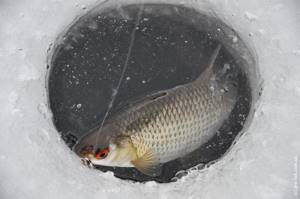
Where to look for roach in December
At this time, the ice on reservoirs is usually already strong, especially towards the end of the month. Winter is getting stronger. In December, the roach will already be in those places that were discussed in the first half of the article. The fish will already gather in schools and will stand in the water area that they have chosen for wintering. The bite, of course, will be calmer than on the first ice, and here the skill of the fisherman, the correct search methods and tactics are more important.
Roach in January and February
Fishing for roach in the middle of nowhere, unlike fishing for other types of fish, is in full swing. In small closed ponds in deep winter, this fish can really be caught poorly and be inactive due to lack of oxygen. But migration in search of food begins at reservoirs. Often at this time, schools of roach come closer to the shore, to the mouths of rivers, gradually entering tributaries and rising higher. Roach fishing in January is often done at night in a tent. In the first half of the night and early in the morning in winter, you can get really hungry.
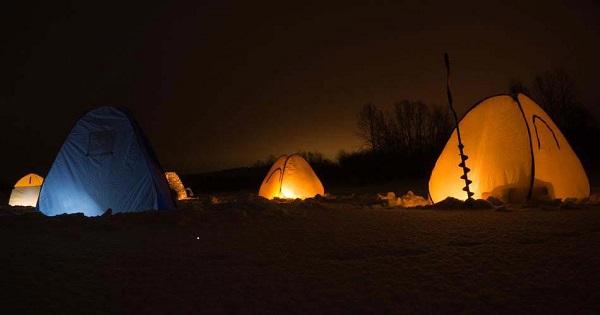
Night fishing
The closer to spring, the more actively the fish feed. In large bodies of water, at the end of winter, roaches gather in large flocks and approach the bays and mouths of tributaries and rivers. If you find a feeding flock, you can catch just a huge amount of it. At such times, you should search at shallower depths. On the last ice, roaches in large reservoirs are caught directly at the mouths of flowing rivers, off the coast, on banks. At this time, she will avoid holes and stay at a depth of 2-4 meters.
Winter forecasts for the bite of large roach
You can judge the activity of this fish in the coming winter by its predatory habits in the fall. Roaches, even very large ones, are by and large not adapted to hunting small fish. If, when fishing for perch in the fall with a small rotating spoon, a blackback is caught in places where bleak accumulates, this means that over the summer it has not gained enough fat for the further development of eggs and milk.
Therefore, there is a high probability that in winter nature will force her to “replenish her reserves” and she will periodically actively feed. Poorly developed reproductive products in large roach caught before the freeze-up is another confirmation of this. You should also take into account the population of bream in a reservoir; if there is a lot of bream in it, it is the master here.
We recommend: Bait for winter fishing for roach on the current: how to prepare it yourself and how to use it?
For other white fish, like roach, there is simply not enough food in it and there will be no blackback here. Although there were cases at large reservoirs, in particular at Mozhaisk in 2008, when a lot of bream died in it during a hot summer. In winter, at depths of 10 m or more, roaches weighing up to 800 grams pecked there. This is such an addiction.
How to catch roach in winter - the right gear
Winter roach fishing requires patience and the right gear from the angler. Thousands of books and articles have been written about how to catch sorog in winter. Each of them describes the “most catchy” method of catching this fish. Perhaps it works in specific conditions. The truth is that the most effective method of winter roach fishing is experimentation. In each of the many reservoirs, and even at different times, the tastes of this fish may differ.
Therefore, no matter where you fish in the winter, with any gear, approach the process of catching this fish creatively, select baits, lures, and jig play. The fact that roaches often move through the water column in winter adds even more options to this process. The main fishing level is the bottom and the lower half-meter layer of water. But often it rises even at half-water, and sometimes to the edge of the ice.
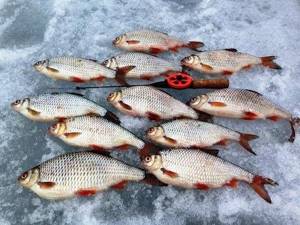
Night roach fishing
On most bodies of water, fishing for roach at night in winter is productive. On reservoirs in winter, towns of tents with lights grow on the ice. It has been noticed that large sorog and ram in winter take bait in some water bodies more boldly at night. Night fishing requires the angler to have a tent and lighting. Usually several holes are drilled and baited; the angler fishes with fishing rods with a float or with a jig with a nod.
Sometimes, especially when fishing at shallow depths and clear water, the hole needs to be shaded with a circle of cardboard or plastic so as not to frighten the fish with light. Occasionally, light, on the contrary, attracts her. It is important to understand that the tent is set up in the evening in a place where fish are known to be present, based on one’s own knowledge or the stories of other fishermen. It is better to arrive for such fishing before dark in order to have time to find the school before nightfall.
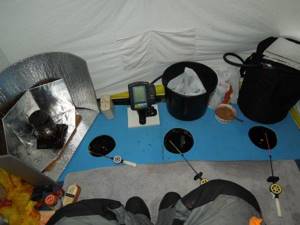
Groundbaits and bait for roach in winter
Loading …
During the cold season, bait creates a cloudy spot, which undoubtedly attracts roaches with its appearance and aroma. This applies to both the dry type of bait, which is simply poured into the holes, and the wet type, from which balls of the appropriate purpose are subsequently molded.
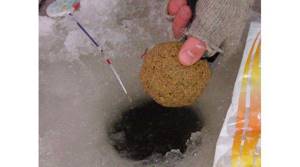
Bait for winter fishing should create a cloudy spot that attracts roaches. Moreover, this applies to both dry bait, which can simply be poured into the hole, and wet bait, from which the corresponding balls are molded.
To create this effect, the following ingredients are added to complementary foods:
- crushed "Hercules";
- milled rice;
- powdered milk.
In addition, the additive must contain components that quickly rise to the surface. You can take crushed sunflower seeds, they will also add aroma. All ingredients are mixed and a dough for catching roach is obtained.

As for bait, it is better to use the well-known maggot or the equally used bloodworm. The remaining attachments are not used often, but can also show good results, but these two are a reliable and proven option.

Don't forget about choosing synthetic baits. Most of them are baitless, but now baits using baits (the same bloodworms) are quite popular. For hunting, it is recommended to adhere to a certain color scheme: black, dark blue. It is better to choose natural material, namely: copper, lead, brass.
Tackle
The technique of catching roach, depending on the gear used, varies:
- Fishing with float tackle.
- Passive fishing with a nod fishing rod from the bottom.
- Active fishing with a jig.
- Reelless fishing.
Tackle for winter fishing for roach needs to be neat and elegant. This is especially true for bodies of water near large cities.
- For roaches in winter, thin fishing lines of 0.08-0.12 mm and small hooks and jigs are used. Only in wild and unintimidated places will rough tackle be suitable.
- Experienced anglers start searching for fish by using the thinnest fishing lines, keeping a fishing rod with 0.16 line in stock. This can be useful in the event of a sudden good bite from a large fish - working on ice with such equipment is easier.
- Equipment for catching roach from ice is selected for each specific case. A heavy jig will not play well on a fishing line that is too thin, and a light jig will sink to the bottom very slowly when using a thick monofilament.
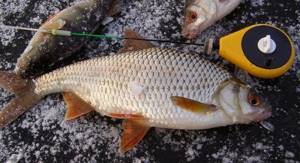
Float rods
Roach tackle with a float in winter works in calm water or weak currents. Fishing rods are often made by hand. Roach bites on float tackle in winter are clearly visible. By experimenting with installation, a working fishing rod configuration is selected directly on the pond. When winter fishing for roach, the equipment uses both hooks and jigs. A detailed description of such winter float gear is here:
https://podlednik.ru/lovlya_zimoj/na-udochku/osnastka-zimnej-udochki-na-plotvu
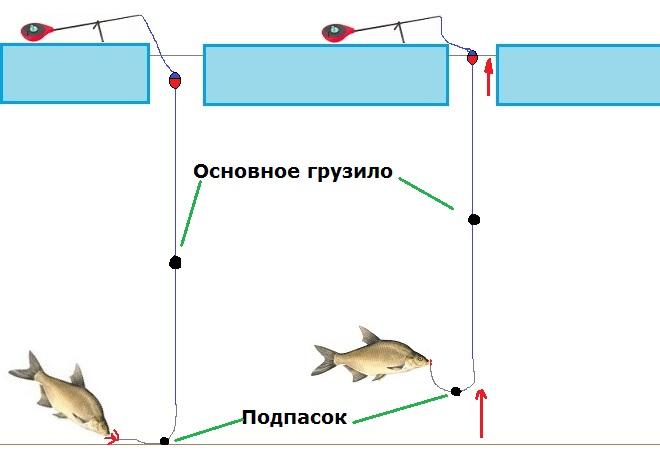
Diversion leash on the current in winter
If there is a strong current that does not allow comfortable fishing with a float or jig, use a fishing rod with a more powerful nod. At the end of such winter gear, it is better to mount a version of feeder installations in a mini version - paternoster, asymmetrical loop, inline. Such tackle with a retractable leash will allow you to fish in winter on large rivers with strong currents.
Detailed article:
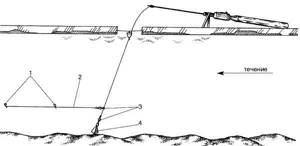
Diagram of a fishing rod with a float for the current
Mormyshka with bloodworms and without a moth
Almost all winter gear for roach uses a jig. In addition to passive fishing with a float, this bait requires active tactics. And it’s better to move around a body of water in search of fish using such equipment. Most anglers hunt this fish with a jig. There are three methods of fishing with such bait in winter from ice:
- Passive method (jigs with bait on the bottom, the bite is determined by the nod).
- Active fishing with a jig with a nozzle.
- Active fishing with a baitless jig (reelless).
For such fishing, a special light fishing rod with a sensitive nod is used. Each method has an army of fans and its own secrets and features. Information about winter fishing with a jig with bait and a riser is disclosed in the article:
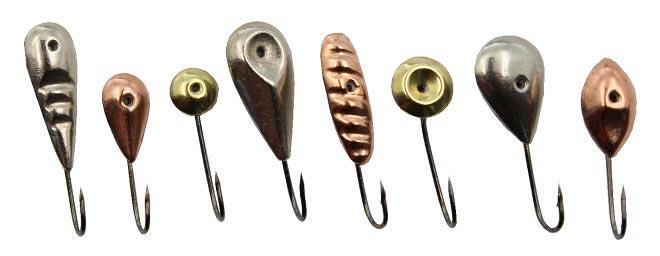
Catching roach with a jig
Also in winter, roaches are also caught using a jig, an important factor of which is the choice of the optimal diameter of the fishing line and the type of jig.
We know that the worse the fish bite, the smaller the diameter of the fishing line should be. But, if you plan to catch roaches larger than average, then you need to select the appropriate equipment for this. To do this, naturally, you need to increase the diameter of the fishing line to 0.15-0.18 millimeters.
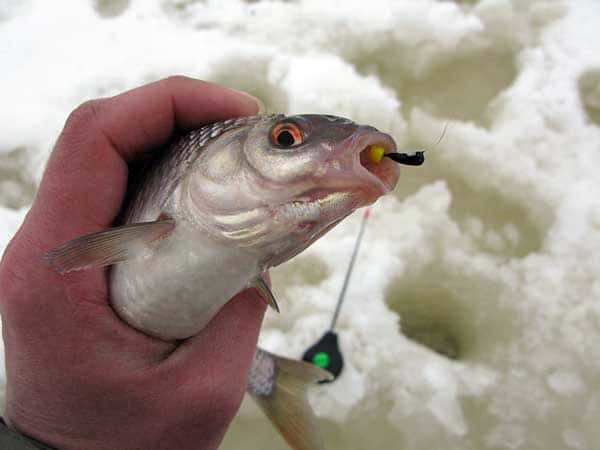
Sometimes, in rare cases, the angler must take into account such a factor as the transparency of the water in the reservoir. Thus, excessively clear water can scare fish away from the fishing spot. But this is most likely suitable for first ice, when there is no snow on the ice and the ice is transparent and smooth.
When fishing with a jig, it is better to use the softest fishing lines. Since playing a jig with a soft fishing line is much more effective than with a hard one.
Although, if it is windy outside, then a soft fishing line will not be entirely convenient, since it will get tangled on ice 2 times more often than a hard one. Also, when fishing for roach, it is not necessary to make too sharp hooks when biting, this can lead to large fish leaving when landing.
The most popular jigs for roach
I would like to give you one more piece of advice on catching roach in winter. If the roach's bite suddenly weakens, it is necessary to carry out additional feeding of the hole.
The main thing is not to bring the feeder to the bottom, but to dump the bait at a distance of 20-40 cm above the bottom. This is necessary so that the food is evenly distributed on the bottom in the fishing area and attracts fish.
And if she approaches, the bait should keep her in this place for a long time, this is the whole essence of the bait.
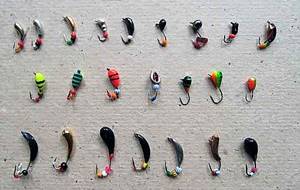
What do roaches bite on in winter - baits and baits
It is known that the traditional winter bait for roaches is bloodworms. In addition to bloodworms, the following baits are used:
- Maggot;
- Cow's udder;
- Burdock moth larva (Chernobyl);
- Worms;
- Salo;
- Dough;
- Semolina chatter;
- Processed cheese.
Contrary to the belief that in winter fish are caught only with animal bait, subglaciers successfully use semolina bait or dough in a syringe, prepared to the consistency of plasticine. Sometimes catching roach with decoy in winter is even more effective than in summer. They even catch it with lard - the sorog is initially attracted to some small white piece. During experiments in winter, you can also use dips, attractants and bite activators, but carefully and in doses.
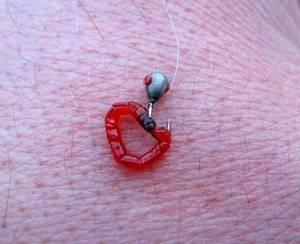
Winter bait
Proper bait is an important element of winter roach fishing. You can experiment endlessly with different smells and attractants, but there are certain rules that always work:
- The bait in winter should be crumbly, and not lie on the bottom in a sticky lump.
- The mass should “dust” in the water.
- The use of bait is not always advisable.
- Specific recipes for winter bait for some reservoirs may be absolutely useless in others.
- Roaches are very fond of turbidity, dusty components and the natural immersion of particles that form a feeding column.
- In winter, you can’t feed a lot - it’s better to add a little at a time to keep the fish at the feeding spot.
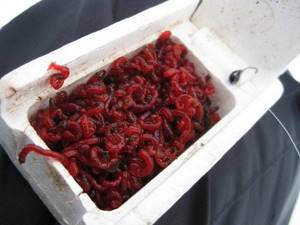
More information about bait:
https://podlednik.ru/nazhivki-i-podkormki/prikormka-dlya-plotvy-zimoj
The success of fishing for roach from ice largely depends on the angler’s willingness to search and experiment. Of course, if the process occurs according to a script, on a specific well-known body of water, where the fisherman knows everything, that’s great. But when exploring unfamiliar bodies of water in winter, the entire process of searching for fish, working gear, and the necessary bait must be done from the very beginning.
Subscribe to the channel:
My YouTube channel RYBAFAN on fishing:
We're OK
Catching roach in winter with a float rod
You can catch roach in winter, as well as bream, using a winter float rig; this is exactly the type of fishing that attracts anglers.
For winter fishing with a float rod, you can use any fishing rod, since the float, and not the nod, serves as a bite alarm.
3 ways to improve your fish bite!
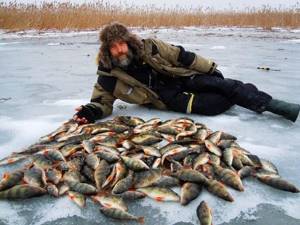
Over 15 years of active fishing, I have found many ways to improve the bite, and here are the most effective:
1. Bite activator . This pheromone additive attracts fish most strongly in cold and warm water. The Fish Hungry bite activator has proven itself to be excellent - Read more…
2. Tackle with increased sensitivity . You should first familiarize yourself with the features of using a particular type.
3. Pheromone baits . They attract the attention of fish, stimulate hunger and cause a schooling reflex, which allows you to collect a lot of fish in one place.
You can get the rest of the secrets of successful fishing for free by reading my other materials on the site.
3 ways to improve your fish bite!
Over 15 years of active fishing, I have found many ways to improve the bite, and here are the most effective:
1. Bite activator . This pheromone additive attracts fish most strongly in cold and warm water. The Fish Hungry bite activator has proven itself to be excellent - Read more…
2. Tackle with increased sensitivity . You should first familiarize yourself with the features of using a particular type.
3. Pheromone baits . They attract the attention of fish, stimulate hunger and cause a schooling reflex, which allows you to collect a lot of fish in one place.
You can get the rest of the secrets of successful fishing for free by reading my other materials on the site.
You don't want to use rods that are too long, but rods that are too short will also be uncomfortable. The best is up to 30 cm, there is no need for anything longer. It is also worth paying attention to the weight of the rod, since if there is a strong side wind, and this can happen quite often, the rod will be blown away.
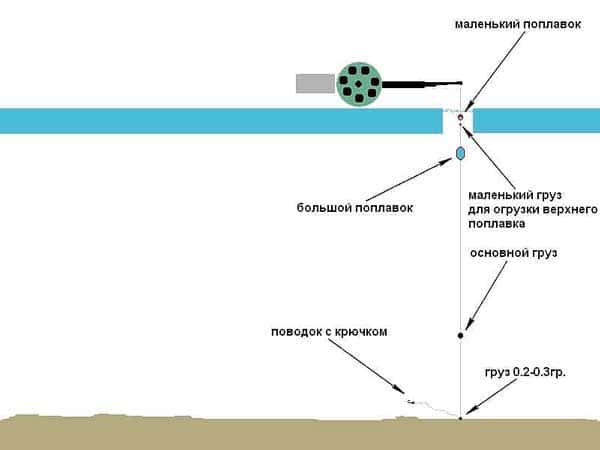
Winter float equipment for roach has the following components:
- A small float , shaped like a cone - 3 - 5 cm; — Sinker in the form of a pellet. This is the case if a hook is used. If you use a jig instead of a hook, then when setting up the equipment, the weight of the jig also needs to be taken into account; - Leash , 10-15 cm long. The line for the leash is selected according to the weight of the fish being caught - 0.10-0.12 mm; — The fishing line should be 0.14-0.18 mm. Although it is now possible to use thinner lines, fortunately they are of better quality, thinner and stronger every year.
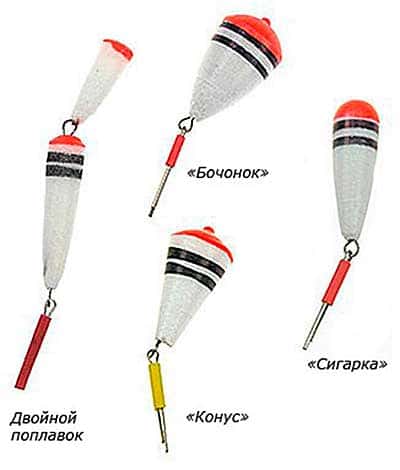
With various changes in weather or atmospheric pressure, the roach behaves more carefully and it is necessary to use more finely tuned gear:
— The hook is smaller than usual; —Leash of smaller diameter; — Small and light float . This is provided that there is no strong current and the depth is fairly shallow, otherwise the tackle will simply be carried away.
In the dead of winter, when the roach is inactive, its bites will be barely noticeable, but it is still possible to see them. And being attentive and focusing your gaze on the float will help you with this.
Floats for winter fishing are sold at any fishing store, or you can make them yourself from polystyrene foam. The main thing is that it has sufficient carrying capacity and is small in size.
